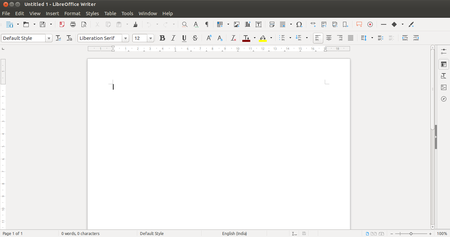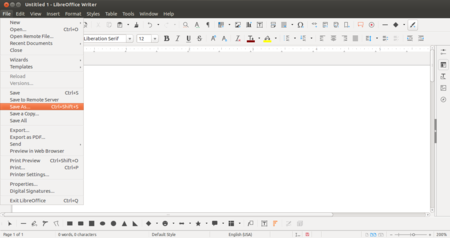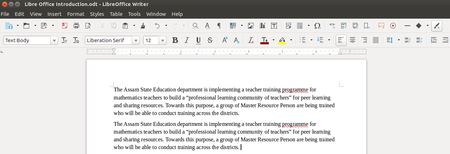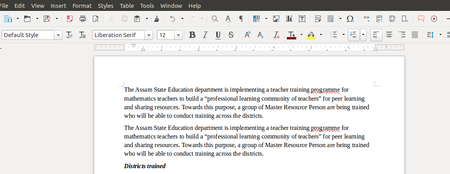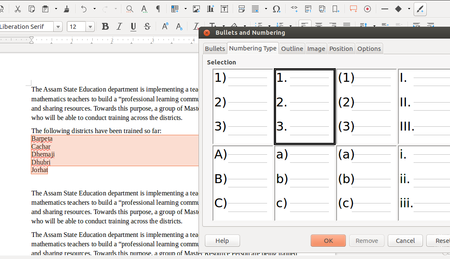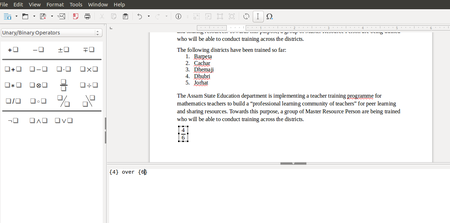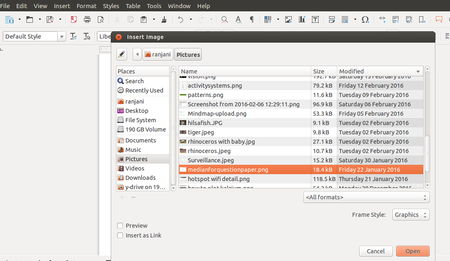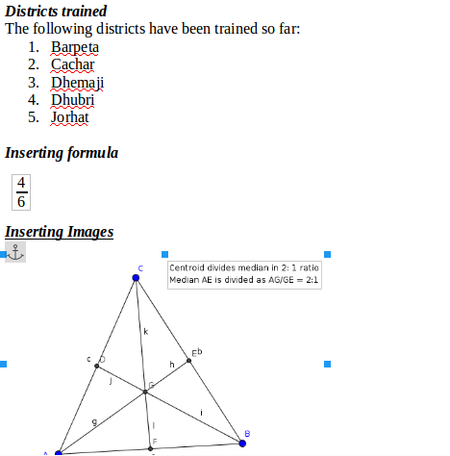Difference between revisions of "Learn LibreOffice Writer"
| Line 27: | Line 27: | ||
{| class="wikitable" | {| class="wikitable" | ||
|- | |- | ||
| − | |style="width: 50%;| | + | |style="width: 50%;| [[File:LO_writer_1_Main_page.png|450px]] |
| − | |style="width: 50%;| | + | |style="width: 50%;| [[File:LO_Writer_2_save_as_option.png|450px]] |
|- | |- | ||
|style="width: 50%;|Step 1-When you click on Application - Office - Libreoffice writer, the main page will show like this. | |style="width: 50%;|Step 1-When you click on Application - Office - Libreoffice writer, the main page will show like this. | ||
| Line 35: | Line 35: | ||
|- | |- | ||
| − | |style="width: 50%;| | + | |style="width: 50%;|[[File:LO_Writer_3_Save_as_window.png|450px]] |
| − | |style="width: 50%;| | + | |style="width: 50%;|[[File:LO_Writer_4_Menu_Bar.png|450px]] |
|- | |- | ||
|style="width: 50%;|Step 3-When you do File Save As it will open a folder, you can select the folder under which you want to save the file. The name of the file is Libre Office Introduction .odt | |style="width: 50%;|Step 3-When you do File Save As it will open a folder, you can select the folder under which you want to save the file. The name of the file is Libre Office Introduction .odt | ||
| Line 47: | Line 47: | ||
|- | |- | ||
| − | |style="width: 50%;| | + | |style="width: 50%;|[[File:LO_Writer_5_Formatting_Page_break.png|450px]] |
| − | |style="width: 50%;| | + | |style="width: 50%;|[[File:LO_Writer_6_Formatting_Page_break.png|450px]] |
|- | |- | ||
|style="width: 50%;|Step 5-Insert Menu has options for entering page breaks, page numbers, formulas and images. | |style="width: 50%;|Step 5-Insert Menu has options for entering page breaks, page numbers, formulas and images. | ||
| Line 55: | Line 55: | ||
|- | |- | ||
| − | |style="width: 50%;| | + | |style="width: 50%;|[[File:LO_writer_7_Bullets_and_Numbering.png|450px]] |
| − | |style="width: 50%;| | + | |style="width: 50%;|[[File:LO_Writer_8_Insert_formula.png|450px]] |
|- | |- | ||
|style="width: 50%;|Steps 7-You can also create numbered lists in a Writer document. | |style="width: 50%;|Steps 7-You can also create numbered lists in a Writer document. | ||
| Line 63: | Line 63: | ||
It will open a window as shown – a left panel which has various options for formulas and a bottom panel in which the formula is to be constructed. | It will open a window as shown – a left panel which has various options for formulas and a bottom panel in which the formula is to be constructed. | ||
|- | |- | ||
| − | |style="width: 50%;| | + | |style="width: 50%;|[[File:LO_Writer_9_Insert_image.png|450px]] |
| − | |style="width: 50%;| | + | |style="width: 50%;|[[File:LO_Writer_10_Inserted_Image.png|450px]] |
|- | |- | ||
|style="width: 50%;|Steps 9-Go to Insert → Image → This will open a folder from which images are to be inserted. | |style="width: 50%;|Steps 9-Go to Insert → Image → This will open a folder from which images are to be inserted. | ||
Revision as of 12:18, 18 October 2016
Introduction
LibreOffice Writer is the free and open-source word processor component of the LibreOffice software package and is a fork of OpenOffice.org Writer. Writer is a word processor similar to Microsoft Word and Corel's WordPerfect, with some identical features.
ICT Competency
A Libreoffice writer is a software used for creating (including writing, editing, formatting, and possibly printing) text documents. Apart from entering and editing text, you can insert images and links also. This software lets you to create a document, store it on the disk, show it on a screen, make changes to it using the keyboard and print it on a printer.
Educational application and relevance
Libre office is an open source for educational use, This program is an alternative for students when it is compared to Microsoft Office.
Version
LibreOffice Writer, Version: 5.2.0.4 (LibreOffice writer is also available on the Windows and Macintosh operating systems)
Configuration
Overview of Features
LibreOffice Writer lets you design and produce text documents that can include graphics, tables, or charts. You can then save the documents in a variety of formats, including the standardized OpenDocument format (ODF), Microsoft Word .doc format, or HTML. And you can easily export your document to the Portable Document Format (PDF).
Other similar applications
LibreOffice Writer, Microsoft Word, OpenOffice.org writer, Web-based text editors (Google Docs) etc are popular text editors.
Development and community help
Developer(s) -The Document Foundation
Stable release:
"Fresh" version:
5.2.2 (September 29, 2016; 14 days ago[1]) [±]
"Still" version:
5.1.5 (August 3, 2016; 2 months ago[1]) [±]
Working with the application
Functionalities
File formats for creation
Saving the file
Like in most applications, a file can be saved using the FILE – SAVE AS command, or by the shortcut key CTRL-S. Always give a meaningful file name, reading which you should get an idea of the file contents.
Export and publishing files
Like in most applications, a file can be exported to a PDF format. This is useful when you only need to print the file and do not want any changes to it.
Advanced features
1 Writing 2 Designing and Structuring 3 Desktop Publishing with LibreOffice Writer 4 Calculations 5 Creating Drawings 6 Inserting Graphics 7 Flexible Application Interface 8 Drag&Drop 9 Help Functions
Installation
| Method of installation | Steps |
|---|---|
| From Ubuntu software Centre | Search Libreoffice |
| From Terminal | sudo apt-get install libreoffice |
| From the web | Go to libreoffice.org and download files to install |
| Web based registration | Not Applicable |
The application on mobiles and tablets
In Andorid Mobiles we can use this application through Open document Reader App and WPS Office App.
Ideas for resource creation
References
{{#related:LibreOffice Calc}} {{#related:LibreOffice Impress}}

